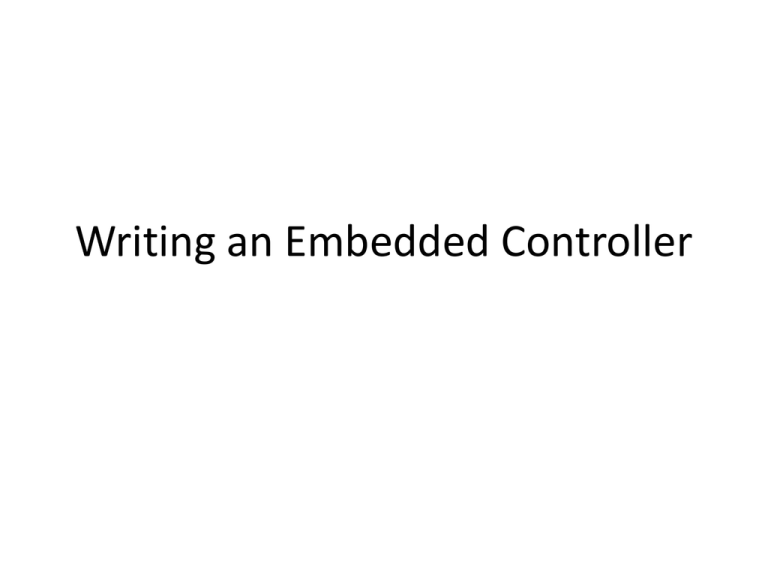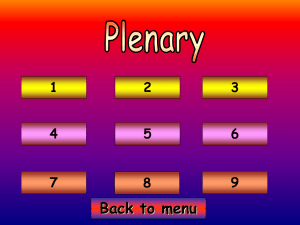Week7_2
advertisement

Writing an Embedded Controller Writing an Embedded Controller • It usually consists of two parts – Initialization – A main loop • Experience: – The main loop usually has to deal with many things. It is important NOT to stay in any job for too long. You should process an event and almost immediately return to the main loop. A Simple Program to Get Started • Write a program which – Prints out “TV is working” every 3 seconds – Print out the ASCII of any key you have pressed immediately. Two Jobs • The simple program has two jobs: 1. A periodical job executed every 3 seconds 2. A job to process the input • Note: – Cannot sleep for 3 seconds and then print out the sentence because cannot process the input while sleeping • Must make sure that each iteration of the main loop is short, such that you can check at a fine time granularity if • need to print status • Has new keyboard input The code should look like loop: if key pressed print ascii value if 3 sec timer expires print msg goto loop .data new_line: .asciiz "\n" msg_tvworking: .asciiz "TV is working\n" .text .globl main main: mfc0 $a0, $12 ori $a0, 0xff11 mtc0 $a0, $12 # read from the status register # enable all interrupts # write back to the status register lui $t0, 0xFFFF ori $a0, $0, 2 sw $a0, 0($t0) li $s0, 300 li $s6, 10000 li $s7, 10000 loop: beq $s6, $s7, mainloopnext1 ori $a0, $s6, 0 li $v0,1 syscall li $v0,4 la $a0, new_line syscall mfc0 $t0, $12 andi $t0, 0xfffe mtc0 $t0, $12 # $t0 = 0xFFFF0000; # enable keyboard interrupt # write back to 0xFFFF0000; # # $s6 used to pass the ascii code # a large number impossible to be an ascii code # print it here. # print the new line # Set Status register # clear ENABLE # write back to status li $s6, 10000 # $s0 used to pass the ascii code mfc0 $t0, $12 ori $t0, 1 mtc0 $t0, $12 # Set Status register # set ENABLE # write back to status A Slightly More Advanced Version • Write a process_input function that responds to `m’, `h’, `q’ (ascii code 109, 104, 112, respectively). • Basically, the TV is initially not in the ``menu state.’’ When the user presses `m’ while the TV is not in the menu state, the TV should show a very simple menu, and enters the menu state: – “`h' to print hello, `q' to quit.” • In the menu state, – if the user presses `h’, print out “Hello!” – if the user presses `q’, print out “quit” and quits the menu state. • If not in the menu state, – the TV does not respond to `h’ and `q’. The Challenge • How do you know whether to respond to ‘h’ or ‘q’ or not? – Should not respond in the normal state – Should respond under menu • A naïve way is to write a process_input function that – Called when ‘m’ is pressed then waits there for ‘h’ and ‘q’ – Problem? The solution • Maintain a global variable to remember if we are in the menu state • Write the process_input function by checking the variable first • The program almost inevitablely has states which makes it complicated. In menu state? y n n Is the key ‘m’ y Print the menu, set the menu state flag Is the key ‘h’ n y Print “Hello” Is the key ‘q’ y Print “Quit”, clear the menu state flag n The code .data menuLevel: .word 0 msg_tvworking: .asciiz "tv is working\n" msg_menu: .asciiz "`h' to print hello, `q' to quit.\n" msg_hello: .asciiz "hello!\n" msg_quit: .asciiz "quit.\n" # -------------------- # -------------------.text .globl main main: mfc0 $a0, $12 ori $a0, 0xff11 mtc0 $a0, $12 # read from the status register # enable all interrupts # write back to the status register lui $t0, 0xFFFF ori $a0, $0, 2 sw $a0, 0($t0) li $s0, 300 li $s6, 10000 li $s7, 10000 # $t0 = 0xFFFF0000; # enable keyboard interrupt # write back to 0xFFFF0000; # # $s6 used to pass the ascii code # a large number impossible to be an ascii code





